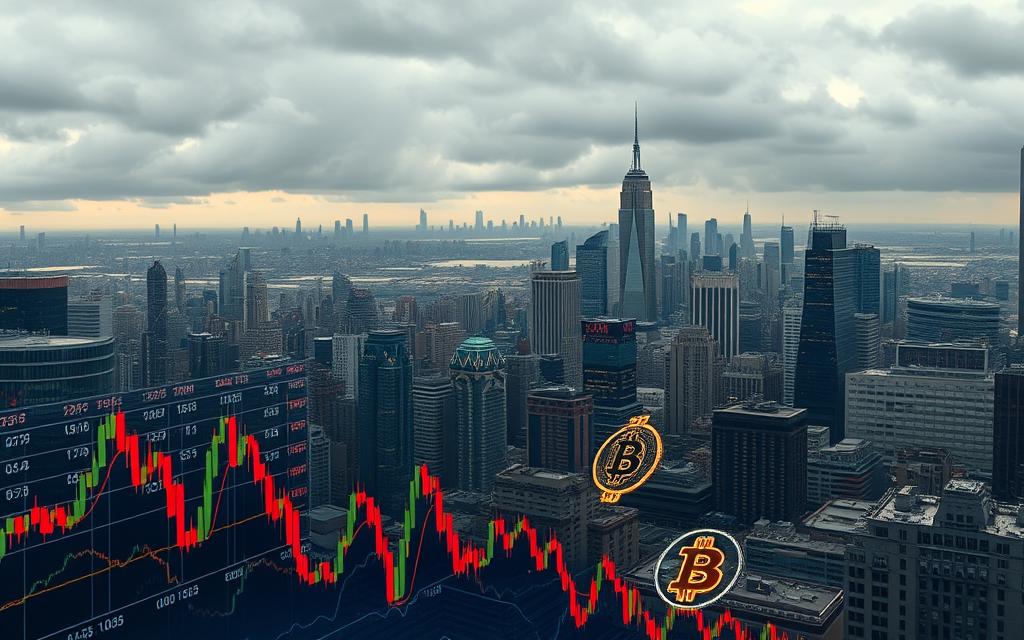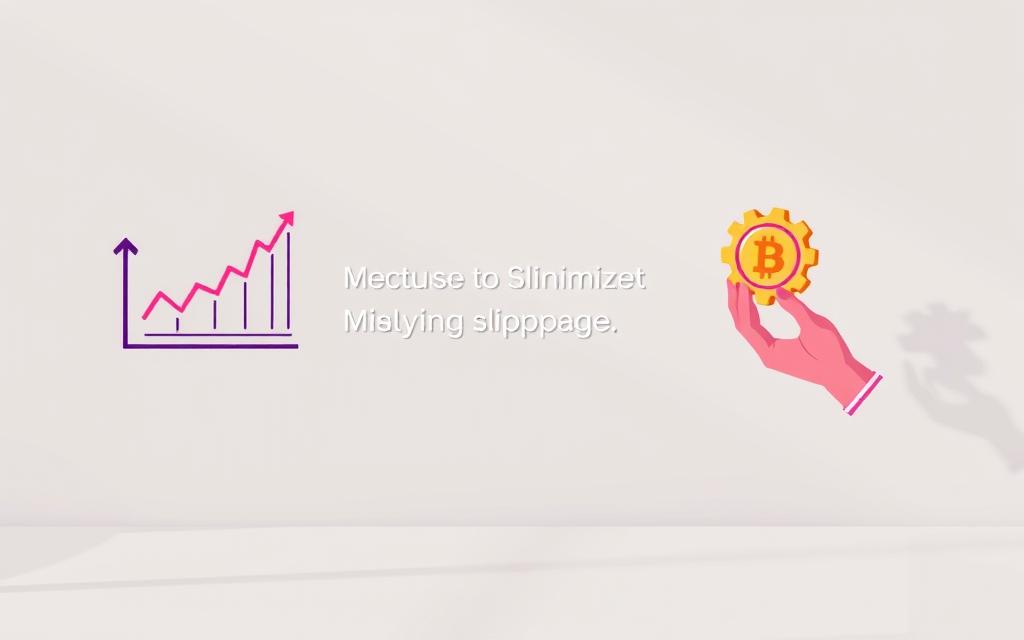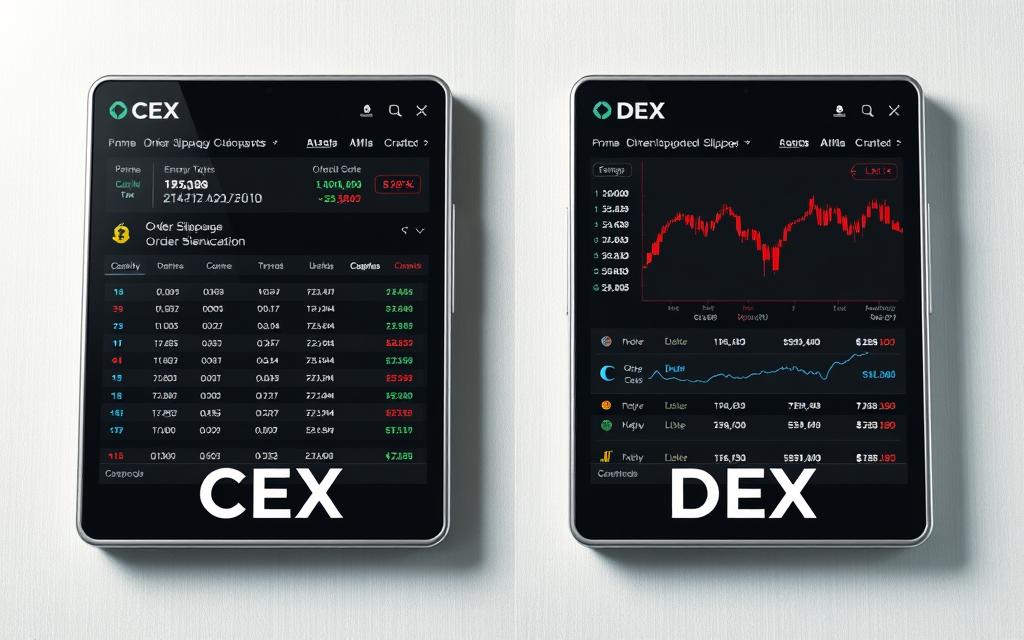Table of Contents
Imagine ordering a dozen cupcakes at a bakery, only to find the price changed before checkout. The same unpredictability happens in crypto trading when orders execute at different rates than expected.
This difference, known as slippage, occurs due to rapid market movements or low liquidity. For example, a $50,000 Bitcoin trade might finalize $500 above or below the intended price.
Memecoins like WIF saw $5.7M losses from large orders in early 2024. Such volatility makes managing slippage crucial for cryptocurrency traders.
While unavoidable, strategic adjustments minimize risks. Understanding these shifts helps traders stay ahead in fast-moving markets.
What Is Slippage in Crypto?
A $10,000 trade might cost $300 more than planned due to hidden market dynamics. This gap between expected and actual execution prices is called slippage. It stems from rapid price shifts or insufficient liquidity in trading pools.
Centralized exchanges (CEX) use order books, where buyers and sellers match manually. Decentralized platforms (DEX) like Uniswap rely on automated liquidity pools, which recalculate asset ratios mid-trade, often causing slippage.
Market orders execute instantly at current rates, while limit orders let traders set maximum price thresholds. Blockchain delays worsen slippage—transactions stuck in mempools may finalize at worse rates.
Uniswap’s default 0.5–1% slippage tolerance helps mitigate losses. Automated Market Makers (AMMs) adjust swap rates based on pool reserves. For example, a $10,000 swap with 3% slippage loses $300 to rate fluctuations.
Why Does Slippage Happen in Crypto Trading?
Rapid market shifts can turn a profitable trade into a loss within seconds. These price gaps occur due to four primary factors: market volatility, low liquidity, network congestion, and large order sizes. Understanding each helps traders anticipate and mitigate risks.

Market Volatility
Bitcoin once swung 20% in a day after regulatory news. Memecoins like PEPE often see 50%+ hourly fluctuations. Such instability widens the gap between expected and actual trade prices.
Low Liquidity
Small-cap tokens with under $1M daily volume suffer drastic price impacts per trade. Even centralized exchanges may fake liquidity through wash trading. Thin order books amplify slippage risks.
Network Congestion
Ethereum’s 12-second block times slow trades during NFT mints, while Solana’s 400ms speed reduces delays. Polygon zkEVM faced similar bottlenecks during major airdrops, worsening execution prices.
Large Order Sizes
Whales moving >5% of a token’s supply trigger cascading price changes. OTC desks split billion-dollar orders to avoid flooding the crypto market. Size directly impacts slippage severity.
Positive vs. Negative Slippage
Not all price changes in trading lead to losses—some can boost profits. This duality defines positive slippage (better-than-expected rates) and negative slippage (worse execution). Traders must recognize both to optimize strategies.
Positive slippage often occurs during volatile recoveries. For example, buying ETH at $1,800 during a flash crash that rebounds to $1,850 nets an instant 2.7% gain. Decentralized exchanges (DEXs) see this 23% of trades due to arbitrage between liquidity pools.
Negative slippage strikes when markets move against traders. Stablecoins like USDC briefly depegging to $0.97 in 2023 caused massive losses for large sellers. Centralized exchanges (CEXs) average 0.8% negative slippage on market orders during high volatility.
| Scenario | Type | Impact |
|---|---|---|
| ETH flash crash recovery | Positive | +2.7% profit |
| USDC depegging event | Negative | 3% loss |
| Elon Musk tweet-induced CEX outage | Negative | Orders fail or overpay |
| DEX pool arbitrage | Positive | 23% of trades benefit |
The IRS treats these gaps as taxable events. A $0.98 buy executing at $1.00 creates a $0.02 difference expected—reportable as income. Conversely, losses from negative slippage may offset capital gains.
How to Calculate Slippage in Crypto
Traders often face unexpected price gaps between order placement and execution—here’s how to measure them. These deviations, called slippage percentage, reveal market risks and help refine strategies.

Formula for Slippage Percentage
The standard calculation compares the executed price to the expected price:
((Actual Price − Expected Price) ÷ Expected Price) × 100
Breakdown:
- Numerator: Absolute dollar difference between rates.
- Denominator: Initial quoted price.
For instance, a token bought at $2.00 but filled at $2.06 has a 3%slippage percentage(($0.06 ÷ $2.00) × 100).
Practical Example
Consider buying 10 ETH at $3,000 per token. If the order executes at $3,050:
| Metric | Value |
|---|---|
| Expected Price | $3,000 |
| Executed Price | $3,050 |
| Slippage | 1.67% |
Tools like TradingView’sSlippage Riskindicator orDEX screener datahelp track these gaps historically.
Institutions mitigate risks using algorithms like TWAP (Time-Weighted Average Price) to split large orders. Understanding these calculations empowers traders to anticipate and adjust for market volatility.
How to Avoid or Minimize Slippage
Traders can reduce unexpected price gaps with smart execution strategies. Proactive adjustments protect profits and improve trade accuracy. Below are four proven methods to mitigate risks.

Using Limit Orders
Limit orders let traders set fixed prices, avoiding unfavorable executions. Platforms like Binance offer “Post-Only” mode to bypass taker fees. Kraken’s Self-Trade Protection prevents accidental OTC overlaps.
Setting Slippage Tolerance
DEXs like Uniswap allow custom slippage tolerance thresholds. Blue-chip tokens work well at 1%, while low-cap altcoins may need 5%+. Uniswap v3’s concentrated liquidity optimizes rates further.
Trading During High Liquidity
Peak volumes at 3PM UTC on centralized exchanges reduce price impacts. Avoid weekends for illiquid assets—thin order books amplify gaps. Timing aligns with global market openings.
Splitting Large Orders
Whales use TWAP bots or iceberg orders to fragment trades. Bitfinex’s algorithms execute batches stealthily. Smaller chunks prevent market flooding and stabilize prices.
| Strategy | Tool/Feature | Impact |
|---|---|---|
| Limit Orders | Binance OCO | Locks in prices |
| Slippage Tolerance | Uniswap v3 | 1–5% flexibility |
| Liquidity Timing | CEX peak hours | Lower volatility |
| Order Splitting | TWAP bots | Reduces price impact |
Combining these strategies maximizes efficiency. Test settings in low-stakes environments before scaling up. Adaptability turns volatility into opportunity.
Slippage Differences: Centralized vs. Decentralized Exchanges
Trading platforms handle price gaps differently—some prioritize speed, others accuracy. Centralized exchanges (CEXs) like Binance rely on order books, while decentralized exchanges (DEXs) automate trades via liquidity pools. These architectures create distinct slippage outcomes.

CEX Order Books vs. DEX Liquidity Pools
CEX order books match buyers and sellers manually. Binance’s depth charts reveal real-time demand, letting traders gauge slippage risks. Market makers earn rebates for adding liquidity, tightening spreads.
DEXs like Uniswap use DEX liquidity pools. Curve Finance optimizes stablecoin swaps, while Balancer allows custom token ratios. Automated pricing adjusts mid-trade, often causing higher slippage for large orders.
“Coinbase’s instant trades include hidden slippage up to 2% during volatility.”
How Platforms Handle Slippage
CEXs minimize gaps with high liquidity. Bybit’s mining programs incentivize deep order books. Coinbase Pro’s ETH/USDC spreads average 0.1%, versus Uniswap’s 0.3%.
DEXs counter slippage via innovations. Uniswap v3’s 0.05% fee tiers cater to stable pairs. Regulatory shifts like MiCA now require CEXs to disclose execution prices transparently.
| Feature | CEX | DEX |
|---|---|---|
| Price Model | Order Book | Automated Pools |
| Slippage Control | Depth Charts | Custom Tolerances |
| Fee Range | 0.1–0.5% | 0.05–1% |
| Regulation | MiCA Compliance | Bot Detection |
Choose platforms based on trade size and asset volatility. CEXs suit high-volume traders, while DEXs offer flexibility for niche tokens.
Conclusion
Mastering slippage crypto trading separates skilled traders from beginners. Tools like Ledger Live’s calculator and Kairon Labs’ algorithms help track and minimize unexpected price gaps.
Key strategies include limit orders and trading during peak liquidity hours. Always check metrics on TokenTerminal before executing large trades. Even Bitcoin averages 0.5% slippage during volatility spikes.
Stay updated with Glassnode reports to adapt to market shifts. Managing these gaps effectively boosts profits and reduces risks. Turn unpredictability into an advantage with disciplined execution.
FAQ
How does market volatility affect slippage?
Rapid price changes increase slippage as orders may execute at less favorable rates than expected. High volatility makes predicting trade execution difficult.
Why does low liquidity lead to higher slippage?
Fewer buyers and sellers mean larger gaps between bid and ask prices. Thin order books struggle to fill trades without impacting the asset’s price.
Can network congestion cause slippage on decentralized exchanges?
Yes. Slow transaction processing on blockchains like Ethereum during peak times delays order execution, often resulting in unfavorable price shifts.
What’s the difference between positive and negative slippage?
Positive slippage occurs when trades execute at better prices than expected, while negative slippage means worse-than-anticipated pricing. Both stem from sudden market movements.
How do limit orders help reduce slippage?
They set fixed buy/sell prices, preventing execution outside specified ranges. Unlike market orders, they avoid surprises during volatile conditions.
What role does slippage tolerance play in trading?
Traders set acceptable price deviation percentages on platforms like Uniswap. If rates exceed this threshold, transactions automatically cancel to protect profits.
Are decentralized exchanges more prone to slippage than centralized ones?
Often yes. DEXs rely on liquidity pools rather than deep order books, making large trades more likely to shift prices compared to CEXs like Binance or Coinbase.
How can traders minimize slippage with large orders?
Splitting big trades into smaller chunks reduces market impact. Algorithms or manual分批 execution help maintain stable pricing across transactions.









